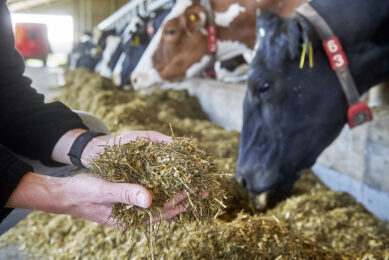6 tips to protect calves against coccidiosis

As coccidiosis is a serious disease that can result in significant economic losses, managing coccidiosis is imperative to ensure healthy young stock.
Managing coccidiosis, and reducing the impact of coccidial infections, depends on allowing a low level of exposure, so that young stock can develop immunity, but preventing levels of infection that will cause decreased growth rates or clinical disease.

Follow the guidance below on how to protect calves (and lambs) against this parasite:
![]()
Treat all animals in a group: if there is no history on which to base a strategic treatment plan, all animals in the group should be treated following a positive diagnosis of pathogenic Eimeria species on routine dung samples, or immediately after clinical signs of coccidiosis are seen.
![]() Take farm history: it is important to get a diagnosis of the species of Eimeria to check if it is a harmful species along with considering the individual farm history. Timing of treatment should be based on the timing of suspected exposure and knowledge of previous outbreaks on the farm.
Take farm history: it is important to get a diagnosis of the species of Eimeria to check if it is a harmful species along with considering the individual farm history. Timing of treatment should be based on the timing of suspected exposure and knowledge of previous outbreaks on the farm.
![]() Treat in time: strategic treatment is often required, and is necessary to prevent losses associated with subclinical infections. Ideally treatment should be given after infection but before the parasite starts damaging intestinal cells and causing clinical signs. This helps to prevent the build-up of environmental contamination, reducing the risk of any animals in the group picking up a heavy infection and suffering from clinical disease.
Treat in time: strategic treatment is often required, and is necessary to prevent losses associated with subclinical infections. Ideally treatment should be given after infection but before the parasite starts damaging intestinal cells and causing clinical signs. This helps to prevent the build-up of environmental contamination, reducing the risk of any animals in the group picking up a heavy infection and suffering from clinical disease.
![]() Ensure good hygiene: water troughs should be cleaned and emptied regularly to help prevent contamination with faeces, and bedding should be kept clean and dry. Good ventilation will also help reduce infection pressure by reducing the build-up of warmth and moisture which favour oocyst survival.
Ensure good hygiene: water troughs should be cleaned and emptied regularly to help prevent contamination with faeces, and bedding should be kept clean and dry. Good ventilation will also help reduce infection pressure by reducing the build-up of warmth and moisture which favour oocyst survival.
![]() Keep animals in similar age-groups: Older animals can act as a source of infective oocysts for younger animals. In addition, providing optimum grouping of young stock will help avoid environmental stressors which can increase risk of disease.
Keep animals in similar age-groups: Older animals can act as a source of infective oocysts for younger animals. In addition, providing optimum grouping of young stock will help avoid environmental stressors which can increase risk of disease.
![]() Ensure adequate colostrum intake: Colostrum taken in shortly after birth allows calves and lambs to absorb whole antibodies, which gives them some protection in the first weeks of life. As these colostral antibodies decline, calves and lambs become vulnerable to infection.
Ensure adequate colostrum intake: Colostrum taken in shortly after birth allows calves and lambs to absorb whole antibodies, which gives them some protection in the first weeks of life. As these colostral antibodies decline, calves and lambs become vulnerable to infection.
Source: Elanco
Join 13,000+ subscribers
Subscribe to our newsletter to stay updated about all the need-to-know content in the dairy sector, two times a week.










